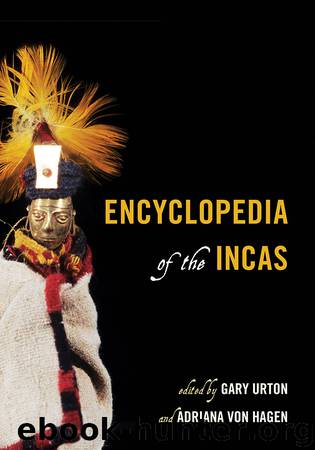Encyclopedia of the Incas by Urton Gary von Hagen Adriana & Adriana von Hagen

Author:Urton, Gary,von Hagen, Adriana & Adriana von Hagen [Urton, Gary & Hagen, Adriana von]
Language: eng, eng
Format: epub
Publisher: Rowman & Littlefield
Published: 2015-06-19T16:00:00+00:00
HUACA
Often glossed as “sacred place,” huaca is a term used frequently by the Spanish chroniclers to invoke a concept that they clearly understood to be a core principle, or value, of Inca and Andean peoples’ religious beliefs and practices, as well as their senses of being and place. It was a concept that should be understood as a central ontological (i.e., concerning the nature of being, or reality) principle in the Inca concept of the universe and the place of humans within it.
The central problem in understanding this important religious concept is that the characterizations of it come largely by way of the Spanish Colonial authors, virtually all of whom were steeped and heavily invested in Spanish Catholic religious beliefs and values—not to mention grammatical constructions. The challenge then is to “read back” through the Spanish chronicles, with the aid of the few indigenous texts available to us (e.g., the Huarochirí Manuscript; see Avila, Francisco de), to try and capture whatever indigenous essence and meaning we may attribute to the term. In short, as we will see, huaca-being was not a petrified, stable, nor fixed state of things; rather, it was a status, value, and quality constructed over time in the worship and tending of an object, the feeding of it, the conversing with it, and the attending to its needs and wishes. The mestizo (half-indigenous/half-Spanish) chronicler Garcilaso de la Vega produced the following characterization:
Huaca . . . means “a sacred thing,” such as . . . idols, rocks, great stones or trees which the enemy [i.e., the devil] entered to make the people believe he was a god. They also gave the name huaca to things they have offered to the Sun, such as figures of men, birds, and animals. . . . The same name is given to all those things which for their beauty or excellence stand above other things of the same kind. . . . On the other hand they give the name huaca to ugly and monstrous things . . . everything that is out of the usual course of nature, as a woman who gives birth to twins . . . double-yolked eggs. (Garcilaso 1966 [1609])
As Garcilaso’s account suggests, virtually any object could be bestowed with huaca identity and, thereby, be accorded the respect and worship, including sacrifices, appropriate to this status. The object, however, had to be a particularly striking, unusual, or wondrous example of its type in order to be considered to possess the supernatural quality of huaca. That is, not just an ear of corn, but a double ear of corn; not just a stone, but a stone believed to be possessed by special powers, such as the gift of making oracular pronouncements (via a human medium devoted to the care and feeding of the stone; see Oracles); not just a human, but a human with a harelip; and not just a bend in a canal, but a point in the landscape attached to wondrous mythological events. Such objects and places were named; accorded regular sacrifices (i.
Download
This site does not store any files on its server. We only index and link to content provided by other sites. Please contact the content providers to delete copyright contents if any and email us, we'll remove relevant links or contents immediately.
| Canada | Caribbean & West Indies |
| Central America | Greenland |
| Mexico | Native American |
| South America | United States |
Cat's cradle by Kurt Vonnegut(13868)
Pimp by Iceberg Slim(12932)
Underground: A Human History of the Worlds Beneath Our Feet by Will Hunt(11258)
4 3 2 1: A Novel by Paul Auster(11052)
The Radium Girls by Kate Moore(10907)
American History Stories, Volume III (Yesterday's Classics) by Pratt Mara L(4826)
Perfect Rhythm by Jae(4621)
Wiseguy by Nicholas Pileggi(4586)
The Fire Next Time by James Baldwin(4343)
Paper Towns by Green John(4169)
A Higher Loyalty: Truth, Lies, and Leadership by James Comey(4033)
Pale Blue Dot by Carl Sagan(4001)
The Mayflower and the Pilgrims' New World by Nathaniel Philbrick(3915)
The Doomsday Machine by Daniel Ellsberg(3731)
Too Much and Not the Mood by Durga Chew-Bose(3696)
Killers of the Flower Moon: The Osage Murders and the Birth of the FBI by David Grann(3609)
The Borden Murders by Sarah Miller(3590)
The Sympathizer by Viet Thanh Nguyen(3481)
Killing England by Bill O'Reilly(3455)
